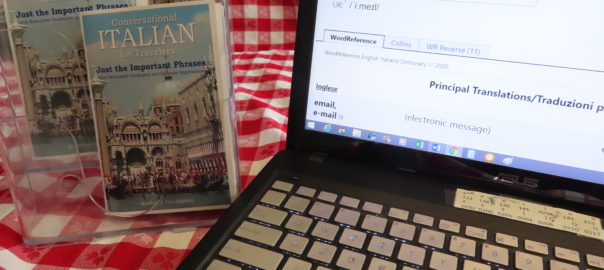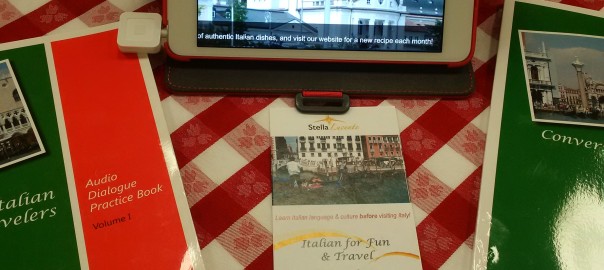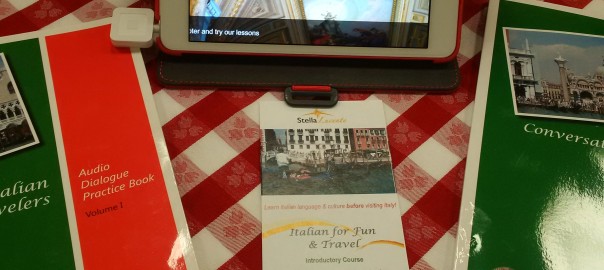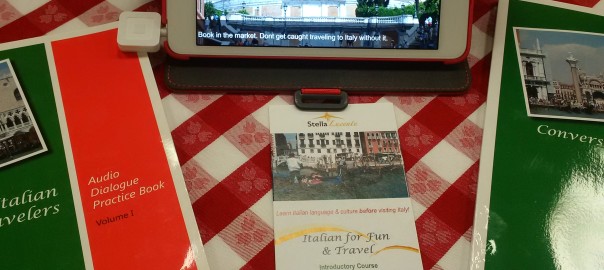 Planning your Italian vacation?
Planning your Italian vacation?
Use our Italian subjunctive mood practice tips to write your own Italian email!
Revisit the Italian subjunctive mood!
Can you speak Italian? By now, many of you have passed the beginning stages of learning how to speak Italian and can read and comprehend quite a bit of the language. Meraviglioso!
But have you tried to take the next step to communicate in Italian fluently? Are you comfortable using email to make plans with your family and friends? Can you use the Italian subjunctive mood and Italian reflexive verbs correctly when making plans?
For our second Italian practice email, we will continue with the story of Caterina and Francesca, two Italian cousins who are living in different cities and trying to reconnect. First, we will present a review of how to describe visiting someone using the verb trovare. Then we will present information about Italian reflexive verbs of emotion and of self-action, and the different meanings of verbs with reflexive and non-reflexive forms. We will also discuss use of Italian prepositions regarding the different places we go in our daily lives and regarding time. Finally, we will describe how to use Italian verbs as nouns.
***************************
A note about the Italian subjunctive mood: to express complex feelings in Italian correctly, it is important to use the Italian subjunctive mood. Using the subjunctive mood is difficult for English speakers, because we only rarely use this tense in English, and it’s something that I am always working on! This is the second blog post in the “Italian Practice” series that focuses on how to use the Italian subjunctive mood, or “il congiuntivo,” when writing an email to your family.
To review how to express one’s feelings using the subjunctive mood and how to conjugate the subjunctive mood in the present tense, see our Speak Italian Subjunctive series.
Enjoy the second blog post in this series, “Italian Subjunctive Mood Practice: Planning Your Italian Family Vacation.”
—Kathryn Occhipinti
Some of this material is adapted from our textbook, Conversational Italian for Travelers © 2012 by Stella Lucente, LLC, found on www.learntravelitalian.com. Special thanks to Italian instructor Simona Giuggioli.
How many phrases that use the subjunctive mood can you pick out of the following emails? Hint: these phrases usually include the word “che.” Look for the underlined phrases for help! Notice that the future tense does NOT have a subjunctive mood! Also, look for reflexive verbs of emotion and self-action and special phrases of visiting that have been italicized for easier comprehension.
Remember these examples as “anchors” in your knowledge for when you try to speak Italian and try out the subjunctive mood in your next Italian conversation!
Italian Subjunctive Mood Practice Email:
Planning Your Italian Vacation
An Email to Francesca
Cara cugina Francesca,
Dear Cousin Frances,
Leggere la tua ultima email mi rende* molto contenta!
Reading your last email makes me very happy!
Sono molto contenta che tu e i tuoi figli possiate venire a trovarmi in Abruzzo.
I am very happy that you and your children can come to visit me in Abruzzo.
Mi dispiace che tuo marito non possa venire con voi.
I am sorry that your husband cannot come with you all.
Di solito, ti prendi cura di lui molto bene ogni giorno!
Usually, you take care of him very well every day!
Ed ora, dobbiamo fare il programma!
And now, we must make up the itinerary!
Spero che tu possa arrivare la domenica prima di Ferragosto.
I hope that you can arrive the Sunday before the Ferragosto holiday.
Per prima cosa, io vorrei portarti a trovare i nostri zii.
First, I want to take you to visit our aunt and uncle.
Sono anziani e io dovrei andare a trovarli ogni domenica.
They are elderly and I should go to visit them every Sunday.
Dopo che andiamo in chiesa di mattina, dobbiamo andare a casa loro.
After we go to church in the morning, we should go to their house.
Sono sicura che nostra zia preparerà una buona cena per noi.
I am sure that our aunt will make a wonderful dinner for us.
Lunedì, vorrei andare in montagna a fare un picnic.
On Monday, I would like to go to the mountains to have a picnic.
Per me, restare in montagne dovrebbe essere molto bello con l’aria fresca e gli alberi verdi.
For me, a stay in the mountains would be very beautiful with the fresh air and the green trees.
Dovremmo avere una buona giornata, no?
We should have a good day, no?
Possiamo prendere un buon apertivo come un Aperol Spritz e chiacchierare un po.’
We can have a nice apertif like an Aperol Spritz and chat a bit.
I ragazzi saranno anche molto contenti di giocare insieme fuori.
The kids will also be very happy to play together outdoors.
Mi piacerebbe molto restare in montagna due or tre giorni.
I would really like to stay in the mountains for two or three days.
Possiamo restare all’Albergo Grande vicino a Capistrello per due o tre giorni.
We could stay at the Albergo Grande Hotel near Capistrello for two or three days.
Tu ricordi che il padrone è anche mio cugino.
You remember that the owner is also my cousin.
Prima che tu ritorni, dobbiamo fare la spesa.
Before you return, we could go grocery shopping.
Puoi comprare il cibo tipico del nostro paese.
You can buy food typical of our town.
Puoi dirmi la verità—il pane a Roma non è buono come il nostro in Abruzzo!
You can tell me the truth—the bread in Rome is not good like ours in Abruzzo!
Pensaci. Fammi sapere che pensi di questo programma!
Let me know what you think of this itinerary!
Non vedo l’ora di vederti!
I can’t wait to see you! (idiomatic expression)
Abbracci e baci,
Hugs and kisses,
Caterina
Kathy
*From the verb rendere, which can mean “to render,” or “to make,” as in “to become.”
Italian Subjunctive Mood Practice Email:
Planning Your Italian Vacation
A Reply Email to Caterina
Cara cugina Caterina,
Dear Cousin Kathy,
Mi sembra che il tuo programma sarà meraviglioso!
It seems (to me) that your schedule will be marvelous!
Sarei molto contenta di restare in montagna con te!
I would be very happy to stay in the mountains with you!
Dopo avere letto la tua email mi sono resa conto che mi mancano molto le montagne dell’Abruzzo.
After having read your email, I realized that I really miss the Abruzzo mountains.
Dopo, andiamo a fare la spesa insieme a Capistrello e così posso portare del buon pane a Roma quando torno!
Afterward, let’s go grocery shopping together in Capistrello, so I can bring some good bread to Rome when I return!
Ho anche una buona idea—
I also have a great idea—
Forse tu puoi venire a trovarmi a Roma e possiamo fare shopping di vestiti.
Perhaps you can come to visit me in Rome, and we can go shopping for clothes.
Lo sai ci sono molti bei negozi di moda a Roma!
You know there are many wonderful, fashionable shops in Rome!
Qualche volta mi annoio di vivere a Roma senza te.
Sometimes I get bored living in Rome without you.
Ma, non mi sono arrabiata con mio marito due anni fa quando ci siamo trasferiti a Roma.
But I didn’t get mad with my husband two years ago when we moved to Rome.
Mi piacerebbe molto andare a trovare i nostri zii in Abruzzo.
I would really like to go to see our aunt and uncle in Abruzzo.
Mi ricordo di avere cenato molto bene a casa di zia Rosa!
I remember having eaten very well at Aunt Rose’s house!
Sarà molto divertente!
It will be very entertaining!
Ci vediamo presto!
See you soon! (Literally “We will see each other soon!”)
Francesca
Frances
Italian Subjunctive Mood Practice:
Planning Your Italian Vacation
You Will Need to Know…
Phrases That Describe Visiting People
Let’s quickly review how to use the verbs trovare and venire to describe visiting someone, which we covered in detail in our last Italian practice blog post, “Emailing Italian Families.” We will also describe how to use the verb portare when bringing someone to visit others. Examples will come from the emails in this blog post. Did you notice these italicized phrases as you were reading?
Trovare means “to find” something.
- When trovare is combined with the verb andare in the phrase “andare a trovare,” the meaning changes into “to go to visit” someone.
Sono anziani e io dovrei andare a trovarli ogni domenica.
Mi piacerebbe molto andare a trovare i nostri zii in Abruzzo.
- Similarly, when trovare is combined with the verb venire in the phrase “venire a trovare,” the meaning changes into “to come to visit” someone.
Vorrei che tu venga a trovarmi in Abruzzo quest’estate.
Sono molto contenta che tu e i tuoi figli possiate venire a trovarmi in Abruzzo.
Forse tu puoi venire a trovarmi a Roma e possiamo fare shopping di vestiti.
- Also, when trovare is combined with the verb portare in the phrase, “portare a trovare,” the meaning changes into “to bring (someone) to visit” someone.
Per prima cosa, io vorrei portarti a trovare i nostri zii.
Italian Subjunctive Mood Practice:
Planning Your Italian Vacation
You Will Need to Know…
Reflexive Verbs of Emotion
Italian reflexive verbs can be tricky for the English speaker because in many situations, reflexive verbs are used in Italian but not in English. In these cases, we must learn to think in Italian! If we think in Italian, using reflexive verbs to refer to changing emotions that one is feeling at the moment does makes sense.
We have already talked about the most common reflexive verbs in the second blog post in the Speak Italian! series, Speak Italian: All About… What I Am Doing! This blog post describes activities of daily living, which are the most common activities that use the Italian reflexive verbs.
Other activities that involve the changing of one’s emotions during the course of daily life are also reflexive, as in the current blog post, when one cousin talks to the other about her feelings about Rome and taking care of her children. Remember that verbs that translate as “to get” in English are reflexive in Italian!
So, if I “get”/ “am getting” angry, bored, embarrassed, offended, or worried, the verbs used to describe this happening within myself will be reflexive in Italian: arrabbiarsi, annoiarsi, imbarrazzarsi, offendersi, and preoccuparsi.
Verbs of “forgetting” and “remembering” that use the word “about” after the infinitive form in English are also reflexive in Italian. These verbs are followed by the preposition di: dimenticarsi di, scordarsi di (colloquial expression), ricordarsi di.
The following list includes the above verbs, and “a few” more!
| accorgersi di/che |
to notice or realize (about self/someone or something else) |
| annoiarsi |
to get bored |
| arrabiarsi |
to get angry/mad |
| aspettarsi |
to expect/ to anticipate |
| confondersi |
to get confused |
| concentrarsi |
to concentrate (on something) |
| dimenticarsi di |
to forget about (something) |
| distrarsi |
to be distracted |
| focalizzarsi |
to focus (on something) |
| imbarrazzarsi |
to get embarrassed |
| interessarsi a |
to take an interest in/ to show an interest in |
| interessarsi di |
to take care of/ to be in charge of |
| offendersi |
to get offended |
| preoccuparsi |
to get worried/worry |
| rendersi conto di/che |
to realize (about self/someone or something else) |
| ricordarsi di |
to remember to do |
| sbronzarsi |
to get drunk |
| scordarsi di |
to forget about (something)(colloquial expression) |
| scusarsi |
to excuse oneself |
| seccarsi |
to get annoyed |
| sentirsi |
to feel |
| sorprendersi |
to get surprised |
| spaventarsi |
to get scared |
| ubriacarsi |
to get drunk |
| vergognarsi |
to be ashamed |
*************************
Notice that the Italian verb that describes getting bored, annoiarsi, sounds very much like the English word “annoyed.” However, don’t get confused (confondersi)! The Italian verb that means “to get annoyed” is seccarsi. And of course, the verb for to feel in Italian is reflexive—sentirsi, not to be confused with the non-reflexive verb that means to hear—sentire.
Here is how this works. When I want to talk about these emotions as they are happening to me, I must use the reflexive pronoun mi for myself. If I want to talk about emotions that I know are happening to someone else, then I must use the correct corresponding reflexive pronoun/verb conjugation (ti, si, ci, vi, si). Remember to leave out the subject pronoun (io, tu, Lei/lei/lui, noi, voi, loro) unless it is necessary for clarification.
All this is easier than it sounds once you give it a try!
Mi arrabio.
I am/am getting angry.
Ti annoi?*
Are you getting bored?
Lei si imbarrazza!
She is getting embarrassed!
Lui si imbarrazza!
He is getting embarrassed!
Ci offendiamo!
We are getting offended!
Vi confondete!
You all are getting confused!
Loro si seccano.
They are getting annoyed.
*The tu and noi forms of arrabiarsi and annoiarsi are irregular and have only one “i” at the ending: tu arrabi e tu annoi.
*************************
You Will Need to Know…
How to Use the Past Tense with Reflexive Verbs
Distrarsi is often used in the past tense, as below. In this case, remember to change the “o” ending of the masculine past participle distratto to an “a” ending to make the feminine past participle distratta if needed.
Mi sono distratto(a).
I got distracted.
Non ho ascoltato il professore perché mi sono distratto(a).
I didn’t hear the professor because I got distracted.
Two other reflexive verbs in our list that are commonly used in the past tense are those of forgetting and remembering: dimenticarsi di and scordarsi di (to forget about something)* and ricordarsi/ricordarsi di (to remember something/to remember to do something).
Mi sono dimenticato(a) di andare alla posta centrale stamattina.
I forgot to go to the post office this morning.
Non mi sono mai scordato(a) di te.
I have never forgotten you.
Mi sono ricordato(a) il nostro aniversario di matrimonio quest’anno!
I remembered our anniversary this year!
Mi sono ricordato(a) di portare il vino per cena stasera.
I remembered to bring the wine for dinner stastera.
*The verb scordare means to make an instrument go out of tune. There is some controversy about the use of scordarsi with the meaning of “to forget,” and in effect giving it the same meaning as dimenticarsi; some linguists consider only dimenticarsi correct Italian. That said, to some Italians scordarsi means to forget something in your heart and dimenticarsi to forget something in your mind (i.e. without involving emotion). In actual, everyday use, most Italians probably consider the two interchangeable.
Italian Subjunctive Mood Practice:
Planning Your Italian Vacation
You Will Need to Know…
How to Say, “I realized…” or “I noticed”*
Lastly, we present examples that use the phrases “rendersi conto di/che,” which means “to realize” and “accorgersi di/che,” which can mean both “to realize” and “to notice.” Accorgersi di/che is most often used when something is recognized, but not necessarily understood.
To realize is rendered in Italian with the reflexive verb phrase rendersi conto. In order to say, “I realize,” we must conjugate the verb rendersi, which has a regular -ere conjugation in the present tense, and then add the word conto to finish the phrase. So, “I realize…” is “Io mi rendo conto…” But, of course, we always leave out the Italian subject pronoun, so the phrase that Italians use is conversation is just, “Mi rendo conto…”
To complete the sentence, just add what you realize in the phrase that follows! The following phrase will most commonly be in the present or past tense, but of course, there are times when we may need to use the conditional or future tenses, depending on our realization.
- Link what you realize about yourself with the Italian conjugation “di” before adding an infinitive verb. Note: you don’t always have to use “di” in this case if you are talking about yourself. But if you do chose to use “di,” the verb in the next phrase must be in the infinitive form.
—-or—-
- Link what you realize about yourself, someone or something else with the Italian conjugation“che”before adding a verb conjugated in the appropriate tense. Remember, if the subject is different in the original phrase and the phrase that follows, you MUST use “che” to link the two phrases.
In English, both “di” and “che” are translated as “that.”
Below are example sentences to show how this all works. These example sentences are true for me. To think of more examples, and try to describe what you realize about yourself!
Mi rendo conto di avere un’ora per preparare la cena.
I realize that I have an hour to make dinner.
Mi rendo conto che ho un’ora per preparare la cena.
I realize that I have an hour to prepare dinner.
Mi rendo conto che hai un’ora per preparare la cena.
I realize that you have an hour to prepare dinner.
Mi rendo conto che desidero sempre imparare di più sulla lingua italiana.
I realize that I will always want to learn more about the Italian language.
********************
Now, let’s say that we recognize something without really understanding what it is about, or what is going on – that is, we notice something. In this case, we can use the reflexive verb accorgersi. This verb also has a regular -ere conjugation and will be followed by either di or che, for the same reasons as we have just described above. To say, “I notice that,” then, use the phrase, “Mi accorgo di/che…”
Again, an example from my life, taking from a time when I was when talking a good friend of mine about a certain movie. Try to think of some examples from your own life!
Mi accorgo che ti piace molto questo film. Vuoi andare a vederlo con me?
I notice that you really like this film. Do you want to go to see it with me?
********************
How to say, “I realize,” or “I notice,” seems simple enough! But wait… we most commonly use the past tense to talk about something that we have realized or have noticed. This, of course, involves conjugating our two verbs in the past tense!
We will use the passato prossimo forms of these verbs for the one time events of realizing or noticing something, which you will remember is formed for reflexive verbs with essere + the past participle. (If you need a general refresher on how to form the passato prossimo, please refer to our book Conversational Italian for Travelers Just the Verbs ).
- The past participle for rendersi is the irregular verb reso, and the ending will need to change to reflect the speaker when using the passato prossimo.
- The past participle for accorgersi is the irregular verb accorto, and the ending will need to change to reflect the speaker when using the passato prossimo.
- So, when I want to talk about what I have realized, I can say, “Mi sono resa conto di/che…” Similarly, a male would say, “Mi sono reso conto di/che…”
- And, when I want to mention what I have noticed, I can say, “Mi sono accorta di/che…” Similarly, a male would say, “Mi sono accorto di/che…”
To complete the sentence, just add what you have realized in the phrase that follows! The following phrase will most commonly be in the present or past tense, but of course, there are times when we may need to use the conditional or future tenses, depending on our realization.
Below is a table to summarize these phrases of realizing and noticing. I’ve made the verbs in the phrase green to differentiate them from the other words in the phrase. Most Italians use these verb phrases so frequently, though, that they say them quickly, and the words usually run together in real-time conversation. Listen carefully for these phrases and then try to use them yourself!
| Mi rendo conto di/che… |
I realize that… |
| Mi sono reso conto di/che… |
I realized that… (male speaker) |
| Mi sono resa conto di/che… |
I realized that… (female speaker) |
|
|
| Mi accorgo di/che… |
I notice that… |
| Mi sono accorto di/che… |
I noticed that… (male speaker) |
| Mi sono accorta di/che… |
I noticed that… (female speaker) |
We had fun in our Conversational Italian! group “discussing” what we all realized during the year 2017 for our talking point this January. Below are some example sentences that I’ve made up thinking back to New Year’s Eve of 2018. (Notice that as a female I have to use resa and accorta.) How many more examples can you think of?
Ieri sera, a Capodanno, mi sono resa conto di essere molto fortunata.
Last night, on New Year’s Eve, I realized that I am very lucky.
Ieri sera, a Capodanno, mi sono resa conto che sono molto fortunata.
Last night, on New Year’s Eve, I realized that I am very lucky.
Mi sono resa conto di avere amici molto cari.
I realized that I have many dear friends.
Mi sono resa conto che ho molti cari amici.
I realized that I have many dear friends.
Mi sono resa conto di avere imparato tante cose importanti dalla mia famiglia.
I realized that I have learned so many important things from my family.
Mi sono resa conto che ho imparato tante cose importanti dalla mia famiglia.
I realized that I have learned so many important things from my family.
Mi sono accorta che era molto freddo a Capodanno.
I noticed that it was very cold on New Year’s Eve.
*The past section is a reprint from the blog: Italian Phrases We Use EVERY Day! What I realized… from ConversationalItalian.wordpress.org, to be published on February 7, 2018.
Italian Subjunctive Mood Practice:
Planning Your Italian Vacation
You Will Need to Know…
Reflexive Verbs of Self-Action
Italian reflexive verbs can be tricky for the English speaker because in many situations, reflexive verbs are used in Italian but not in English. In these cases, we must learn to think in Italian! If we think in Italian, using reflexive verbs to refer to the things we are doing at the moment makes sense.
We have already talked about the most common reflexive verbs in the second blog post in the Speak Italian! series, Speak Italian: All About… What I Am Doing! This blog post describes activities of daily living, which are the most common activities that use the Italian reflexive verbs.
Other activities that involve actions relating to the self are reflexive in Italian. They refer to what a person (oneself) is doing. Here is a short list:
| divertirsi |
to enjoy oneself/to have fun |
| divertirsi a |
to enjoy… / to play with |
| incontrarsi |
to meet (planned) |
| informarsi di/su |
to ask/inquire about something |
| nascondersi |
to hide |
| occuparsi di |
to work at a job or a task |
| perdersi |
to get/be lost |
| prepararsi (a) |
to get ready (to) |
| provarsi |
to try on clothes |
| rilassarsi |
to relax |
| riposarsi |
to rest |
| sbrigarsi |
to hurry up |
| sedersi* |
to sit down |
| smarrirsi |
to get/be lost |
*Sedersi has an irregular conjugation.
*************************
You Will Need to Know…
How to Say You are Having Fun
“Divertirsi, Divertente, Divertimento”
One of the most important verbs listed in the last section is divertirsi, which is the verb that Italians use to say that they are enjoying themselves or having fun. There is a lot of fun to be had in Italy, so it is worthwhile to learn how to use this verb, as well as the adverb divertente and the noun divertimento.
To tell someone, “Have a good time!” use the phrase, “Buon divertimento!” To use the verb divertirsi and the adverb divertente see below:
| Mi diverto! |
I am enjoying myself/having fun! |
| Mi diverto a guardare la TV (televisione). |
I enjoy watching TV. |
| Mi sono divertito(a)! |
I had fun!/I had a good time! |
| Mi sono proprio divertito(a)! |
I really had fun/a good time! |
| |
|
| È divertente! |
It is fun/entertaining/enjoyable. |
| È divertente parlare italiano. |
It is fun to speak Italian. |
| Era divertente! |
It was fun/entertaining/enjoyable/a good time. |
| Era proprio divertente! |
It was really a lot of fun/entertaining/enjoyable/a good time! |
Italian Subjunctive Mood Practice:
Planning Your Italian Vacation
You Will Need to Know…
“Prendersi Cura di…” and “Occuparsi di…”
Reflexive Phrase of Taking Care
When one person is taking care of another person (or living thing), the reflexive phrase “prendersi cura di…” is used in Italian. The reason that this concept is reflexive in Italian may be that the caring originates within an individual person (myself, for instance), although the action of caring/taking care of is directed at another person. The easiest way to remember this concept is by examples (see below).
The preposition “di” at the end of this phrase must be combined with the definite article (il,la,lo, l’, i, gli, le) if one is not referring to a family member. Also, remember that the subject pronoun is usually left out of the sentence, except for clarification.
Mi prendo cura di mio figlio.
I take care of my son.
Ti prendi cura di tuo nipote?
Do you take care of your nephew?
Lei si prende cura della classe quando l’insegnante non c’è.
She takes care of the class when the teacher is away.
Lui si prende cura della sua famiglia.
He takes care of his family.
Ci prendiamo cura degli ospiti.
We take care of the guests.
Vi prendete cura degli animali nella fattoria.
You all take care of the animals on the farm.
Loro si prendono cura dei loro nipoti.
They take care of their grandchildren.
********************
When a person is taking care of something, the reflexive phrase “occuparsi di…” is used in Italian. The reason that this concept is reflexive in Italian may be that the caring originates within an individual person (myself, for instance), although the action of caring/taking care of something is directed at something. Often this involves someone’s occupation, but it could also involve just one task.
Me ne occupo io.
I will take care of this.
Te ne occupi tu.
You will take care of this
Ti vuoi occupare di questo?/ Te ne vuoi occupare?
Do you want to take care of this?
Lui si occupa del ristorante della sua famiglia.
He takes care of his family’s restaurant.
Da decembre mi occuperò di trovare un nuovo impiegato.
From December I will take care/have the task of finding a new worker.
Italian Subjunctive Mood Practice:
Planning Your Italian Vacation
You Will Need to Know…
Different Meanings of Verbs
with Regular and Reflexive Forms
Many Italian verbs have regular and reflexive forms. If the action is directed back toward the speaker, use the reflexive form. For the verbs ricordare and ricordarsi, in most situations, either form may be used. When speaking of something one needs to remember to do, use ricordare di, as we learned in the last chapter, or ricordarsi di.
Note also that the meaning of a verb may change with use of its reflexive form. Chiamare, for instance, means to call someone, as in to make a call on the telephone or to call out to someone. But chiamarsi means to call oneself by name. Sentire refers to the senses, and can mean to hear, to feel (as in to touch something) and also to smell. But the reflexive verb sentirsi has the very different meaning of to feel an emotion.
| aspettare |
to wait/wait for |
aspettarsi |
to expect/anticipate |
| chiamare |
to call |
chiamarsi |
to call onself/to name |
| fermare |
to stop an object |
fermarsi |
to stop oneself |
| incontrare |
to meet by chance |
incontrarsi |
planned meeting |
| informare |
to inform/to educate |
informarsi di/su |
to ask/to inquire |
| lavare |
to wash |
lavarsi |
to wash oneself |
| mettere |
to put/place |
mettersi |
to put on clothing |
| occupare |
to be occupied |
occuparsi di |
to work at a job or a task |
| essere occupato con… |
to be busy with (something) |
|
|
| preparare |
to get something ready |
prepararsi |
to get oneself ready |
| provare |
to try/practice/rehearse |
provarsi |
to try on clothes |
| ricordare* |
to remember |
ricordarsi |
to remember something |
| ricordare di |
to remember to do… |
ricordarsi di |
to remember to do… |
| sentire |
to hear/to feel (sense of touch)
to smell |
sentirsi |
to feel (emotions) |
| spostare |
to move |
spostarsi |
to move oneself |
*Incidentally, Romagnol dialect (from the Emiliano-Romangnolo region) for “I remember,” is “amarcord,” which is also the name of a famous Italian comedic film from the 1970s by the director Federico Fellini.
Italian Subjunctive Mood Practice:
Planning Your Italian Vacation
You Will Need to Know…
Italian Prepositions “a” and “in” for Places
In English, we go “to” a place or we are “in or “at” a place. In Italian, two prepositions are used to express both where we are going and where we are: “A” and “in” both can mean “to, in, and at.”
Note that in English, the preposition “to” is used to describe the motion of going somewhere, but once a person has arrived where they are going, the prepositions “in” or “at” are used.* So the English preposition changes based on whether one is going to or is in a place.
In Italian, the motion of going to or being in a place does not change preposition use. The preposition is selected depending on the noun that the preposition modifies.
The Italian prepositions are then often (but not always) linked with the Italian definite article (il, la, l’, lo, i, le, gli).
Try as I may, I cannot find a reason for the difference in Italian preposition use for each individual place, although in some cases the Italian use of prepositions seems to mirror British English, rather than American English (the British go “in hospital,” as do the Italians). I guess we have simplified things here in America, across the ocean from the land of our mother tongue!
So therefore, these Italian preposition/noun combinations just need to be memorized. Just link them to the actual place one is going to or one is in and this combination will not change!
See the table below:*
| Do you want to go… |
|
Are you… |
|
Vuoi andare…
Sei… |
|
|
home? |
|
at home? |
|
a casa? |
|
to a restaurant? |
|
at/in the restaurant? |
|
al ristorante? |
|
to a (coffee) bar? |
|
at/in the (coffee) bar? |
|
al bar? |
|
to a cafe? |
|
at/in the cafe? |
|
al café? |
|
to the museum? |
|
at the museum? |
|
al museo? |
|
to the movies? |
|
at the movies? |
|
al cinema? |
|
to the concert? |
|
at the concert? |
|
al concerto? |
|
to the show (performance)? |
|
at the show? |
|
allo spettacolo? |
|
to the show (exhibit)? |
|
at the exhibit? |
|
alla mostra? |
|
|
|
|
|
|
|
to a hospital? |
|
at the hospital? |
|
in ospidale? |
|
to a pizzeria? |
|
at/in the pizzeria? |
|
in pizzeria? |
|
to the piazza? |
|
at/in the piazza? |
|
in piazza? |
|
to church? |
|
at/in church? |
|
in chiesa? |
|
to the beach? |
|
at the beach? |
|
in spiaggia? |
|
to the sea? |
|
at the seaside? |
|
al mare? |
|
to the mountains? |
|
in the mountains? |
|
in montagna? |
|
to the country? |
|
in the country? |
|
in campagna? |
*You will notice from this list that the use of the English prepositions “in” and “at” is also a bit idiomatic. To my mind, and I am sure this can be debated, when someone is surrounded by 4 walls or are in some way completely surrounded, they are “in” a place.
An English speaker is always “at home.” If a person has just arrived, or is standing outside the door of a new place, they are “at” this place. If one then wants to emphasize that they have settled down into this new place, i.e. have a table at a restaurant, the preposition “in” then comes into play.
Also, if a person is involved in what is happening at a particular place, they are “in” it; a viewer is “at” a show, but a performer is “in” the show. And, of course, we all stand “in”‘ line before the show or another event begins!
These explanations may be a bit more complicated than needed, though, and I am sure these prepositions are thought of as interchangeable in many situations by English speakers.
Italian Subjunctive Mood Practice:
Planning Your Italian Vacation
You Will Need to Know…
Italian Preposition “di” for Time of Day
Sometimes it is necessary to emphasize the time of day in Italian, as in morning, afternoon, evening, or night. This is simple in Italian! Just combine the preposition “di” with the time of day: di mattina, di pomeriggio, di sera, or di notte.
Dopo che andiamo in chiesa di mattina, dobbiamo andare a casa loro.
After we go to church in the morning, we should go to their house.
Here are some examples where the time of day is added after stating the numerical time for clarity or for emphasis. (Notice that the Italian language uses a comma rather than a colon to separate the hours from the minutes.)
1,00 (AM) È l’una di mattina.
1,00 (PM) È l’una di pomeriggio.
6,00 (PM) Sono le sei di sera.
10,00 (PM) Sono le dieci di notte.
Italian Subjunctive Mood Practice:
Planning Your Italian Vacation
You Will Need to Know…
How to Use the Italian Infinitive Verb
as a Noun
Every now and then, one needs to use a verb as a noun. In this situation, for the English language, we use the gerund, or “-ing” form, of our verb. For instance, take the sentence, “Reading is fun.” The very first word is the “-ing” form of the verb “to read,” but in this case, the verb is actually the subject of the sentence and is doing the work of a noun!
In the Italian language, the infinitive form of the verb is used when a verb takes the place of a noun. For the present tense, only the infinitive form of the verb is needed. For the past tense, the helping verb will be in the infinitive form before the past participle.
In the email example in this blog post, this occurs in three sentences, which are reprinted below.
Leggere la tua ultima email mi rende molto contenta!
Reading your last email makes me very happy!
Dopo avere letto la tua email mi sono resa conto che mi mancano molto le montagne dell’Abruzzo.
After having read your email, I realized that I really miss the Abruzzo mountains.
Mi ricordo di avere cenato molto bene a casa di zia Rosa!
I remember having eaten very well at Aunt Rose’s house!
-Some of this material is adapted from Conversational Italian for Travelers, © 2012 by Stella Lucente, LLC.

Kathryn Occhipinti, MD, is the author of the
Conversational Italian for Travelers series of books and a teacher of Italian for travelers to Italy in the Peoria and Chicago area.
“Everything you need to know to enjoy your visit to Italy!”
Join my Conversational Italian! Facebook group and follow me on Twitter at StellaLucente@travelitalian1 and start to learn Italian today for FREE!
Conversational Italian! Facebook Group
Tweet @travelitalian1 for Stella Lucente Italian
YouTube videos to learn Italian are available from © Stella Lucente, LLC.
Learn Conversational Italian.
More information on and photographs of Italy can be found on Facebook Stella Lucente Italian and Pinterest Stella Lucente Italian.
Facebook Stella Lucente Italian
Pinterest Stella Lucente Italian
Visit learntravelitalian.com/download.html to purchase/download Conversational Italian for Travelers and find more interesting facts and helpful hints about getting around Italy! Learn how to buy train tickets online, how to make international and local telephone calls, and how to decipher Italian coffee names and restaurant menus, all while gaining the basic understanding of Italian that you will need to know to communicate easily and effectively while in Italy. —From the staff at Stella Lucente, LLC
Italian Subjunctive Practice: Planning Your Italian Vacation
Speak Italian like a native when you use the Italian verb “Prendere”!










